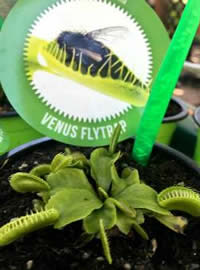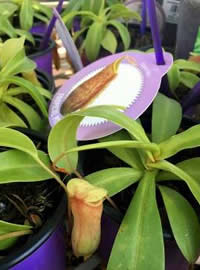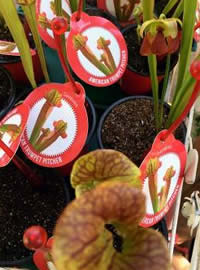 At some point everybody has heard of a Venus Flytrap. It’s not all “Little Shop of Horrors” and Carnivorous plants are more than just fly eating plants there are different ones that eat a variety of insects including mosquitoes and more. Interesting educational, something different and just what one needs to spark an interest in plants and the environment for young minds.
At some point everybody has heard of a Venus Flytrap. It’s not all “Little Shop of Horrors” and Carnivorous plants are more than just fly eating plants there are different ones that eat a variety of insects including mosquitoes and more. Interesting educational, something different and just what one needs to spark an interest in plants and the environment for young minds.
What do they need?
Bug eating plants are mostly from tropical regions and as such need hot and humid conditions to thrive. Make sure that your carnivorous plant receives sufficient light. They are best grown outside in sun to half day sun. If you grow them indoors they need the hottest and brightest spot but not getting sun through a window as that might burn them.
Through winter if you have been growing them outside move them to a more protected spot as they are cold tender. Move them indoors into a bright room or on a patio where they don’t get to much wind.
 |
 |
Keep them well watered. Use rain, distilled or reverse osmosis/filtered water. Water them from the bottom and never let them dry out. Most varieties except the vine Pitcher plant are bog plants and do best if kept wet and not allowed to dry out.
Place the plants in a drip tray that can be constantly filled with water. They are sensitive to chemicals and especially those found in tap water so be careful to teach young gardeners the difference to ensure that the plant survives.
Repot them every second summer or into larger containers using only a specially formulated soil that contains sphagnum peat and washed silica sand.
Bug plants quick guide: NO chemical fertilisers, pesticides or ordinary soil. Feed the plant with live insects only.
 |
 |
Collect them all
There are not that many available but the selection is growing every year as they become more popular with the millennial gardener. Look out for some of our favourites:
American Trumpet Pitcher: Sarracenia
The leaves have evolved into fall traps with digestive capabilities. Colourful pitchers and alluring scent attract the insect to fall into trap. A self-sufficient hunter and very effective, organic means of pest control. Large plants can catch up to a 100 flies a day. They can live for many years and full grown plants reach around 1 meter in height.
Sundew: Drosera
More than 180 distinguished sundew species have been identified and there are quite a few indigenous ones to South Africa. Their name is derived from the Latin word meaning ‘dewy.’ The leaves of the Sundew have evolved into glue traps with digestive capabilities. Tentacles cover the leaves and are tipped with nectar glands that secrete a very sticky, glistening fluid that traps prey. As the insect struggles to free itself, the tentacles wrap around the insect.
 |
 |
Tropical Pitcher: Nepenthes
There are around 140 different types of Tropical Pitchers growing around the world from almost every tropical country. The leaves have evolved into brightly coloured fall traps that give have a fragrant nectar attractive to insects. Lives in nutrient poor conditions so catches insects to supplement its diet to get all the nutrients and minerals it needs. A self-sufficient hunter and very effective organic means of pest control. Larger species can even catch rats, birds, lizards and frogs!
Venus Fly Trap: Dionaea
Venus flytraps originate from North Carolina in the South Eastern part of the USA. The leaves have evolved into spring traps with bright pigment, sweet smells and sugary nectar that attract prey. When trigger hairs inside a trap are activated by an insect causing trap to instantly snap shut and digestive enzymes start breaking down the soft part of insect leaving a dry, powdery husk. Traps reopen after a few day. A single trap can open around 3 - 4 times before it dies.
NB!!!Do not stick your finger in the plant’s trap. It does not like it.
 |
 |






